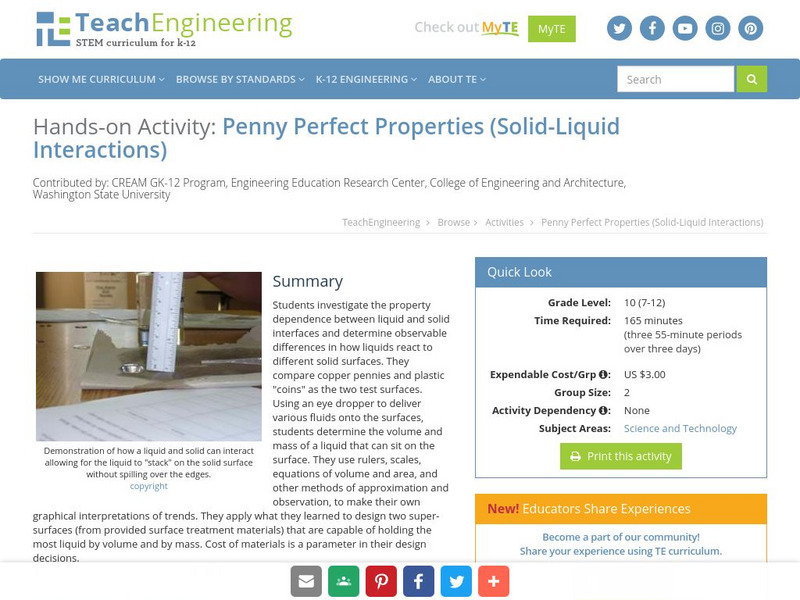Curated OER
Faster speed-Shorter Time
Students calculate the inverse variation, and speed given the formulas. In this algebra lesson, students investigate properties of conics, focusing on the hyperbola. They identify the distance between the directrix and other parts...
Curated OER
Light My Fire!
Students draw a diagram that shows the law of reflection. In this physics lesson, students investigate the relationship between the angle of incidence and angle of reflection. They explain how light travels as it reflects on a surface.
Curated OER
Sugar Bush Sap Production - Human Environmental Impact on Sap Sand
Eleventh graders compare the amount of sugar sand present in tree sap. In this environmental science lesson, 11th graders measure different tree circumference. They prepare a report and share findings in class.
Curated OER
The Nesting Habits of Folders
Students create an organized web of nested grade level folers. Within each grade level folder, they create a Language Arts/Social Studies folder and a Math/Science folder. All folders be color coded.
Curated OER
Snowboarding: Who, What, Where, When, Why?
Students research the Who, What, Where, Why, and When of snowboarding, and then produce a Webzine (magazine) to showcase their new knowledge.
Curated OER
Downhill Skiing: Past, Present, and Future
Students research the history of Olympic downhill skiing to gather information on names, dates, winning times, and the native country of Olympic downhill medal winners.
Curated OER
Earthworms
Fifth graders research the earthworm and write a one paragraph report on its anatomy and habitat. They learn about worms and how to dissect them through Video Streaming and virtual dissections, along with actually dissect a worm as...
Curated OER
The Planets Moon
Pupils explore the theories of the creation of the universe and examine the properties of celestial bodies. They analyze the relationship between the sun, Earth and other planets. They discover the infinite potential of the science of...
Curated OER
The Planets Terra Firma
Students explore the theories of the creation of the universe and examine the properties of celestial bodies. They analyze the relationship between the sun, Earth and the other planets.
Curated OER
Creating Dinosaurs from Tracks
Students learn how scientists compare dinosaur tracks to those of modern animals, how scientists create a full model of a dinosaur from its tracks and how the age of dinosaur tracks is determined.
Curated OER
It's A Jungle Out There!
Students report on an animal according to its appearance, habitat, and characteristics.
Curated OER
Exploring the Celestial Neighborhood
Ninth graders study the origin and organization of the solar system. They investigate the Earth's place in the system and how planetary motions explain natural phenomena observable from Earth.
Curated OER
Image Processing in the Classroom
Twelfth graders determine how scientists study the universe and particular astronomical objects using Internet research, images and NIH software. They work in groups to examine and use imaging software as they study astronomical objects.
Curated OER
Florida the Best WebQuest
Students create a multimedia presentation demonstrating that Florida is the Best State in this creative project for the early elementary classroom. The lesson can be adapted for any state or country.
Curated OER
The Amazing Race
Seventh graders engage in a discussion to determine their experience with traveling. Ask them to describe differences in transportation, currency, culture, food, accommodation, etc. Then they discuss the different expenses one has when...
Curated OER
The Queen's Empire
Eighth graders study insects and make observations about their habitat. in this insect research lesson students research the Internet to compile information on ants.
TeachEngineering
Teach Engineering: Ball Bounce Experiment
Many of today's popular sports are based around the use of a ball, yet none are completely alike. In fact they are all designed with specific characteristics in mind. Students will investigate different balls' abilities to bounce and...
Other
Ogre 3 D: Open Source Graphics Engine
This site contains information about graphics rendering and is the official Ogre 3D site.
TeachEngineering
Teach Engineering: Working Together to Live Together
Students experience civil and environmental engineering by planning a housing development in an existing biome, while also protecting the native species that live there. They conduct research, draw plans, make brochures and give...
TeachEngineering
Teach Engineering: Penny Perfect Properties (Solid Liquid Interactions)
Students investigate the property dependence between liquid and solid interfaces and determine observable differences in how liquids react to different solid surfaces. They compare copper pennies and plastic "coins" as the two test...
TeachEngineering
Teach Engineering: Renewable Energy Living Lab
Students become familiar with the online Renewable Energy Living Lab interface and access its real-world solar energy data to evaluate the potential for solar generation in various U.S. locations. They become familiar with where the most...
TeachEngineering
Teach Engineering: Start Networking!
To get a better understanding of complex networks, students create their own, real social network example by interacting with their peers in the classroom and documenting the interactions. They represent the interaction data as a graph,...
TeachEngineering
Teach Engineering: Flow Charting App Inventor Tutorials
Students design and create flow charts for the MIT App Inventor tutorials in this computer science activity about program analysis. In program analysis, which is based on determining the behavior of computer programs, flow charts are an...
TeachEngineering
Teach Engineering: Program Analysis Using App Inventor
In computer science, program analysis is used to determine the behavior of computer programs. Flow charts are an important tool for understanding how programs work by tracing control flow. Control flow is a graphical representation of...























